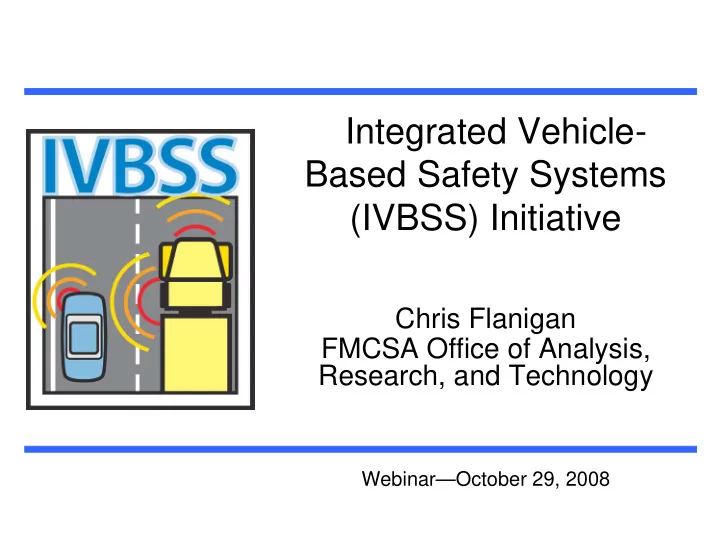

Integrated Vehicle- Based Safety Systems (IVBSS) Initiative Chris Flanigan FMCSA Office of Analysis, Research, and Technology Webinar—October 29, 2008
What is the IVBSS Program? • University of Michigan Transportation Research Institute (UMTRI)-led cooperative agreement with U.S. Department of Transportation (DOT) – National Highway Traffic Safety Administration (NHTSA) and Federal Motor Carrier Safety Administration (FMCSA) • Develop integrated crash warning systems in light vehicles and heavy trucks to estimate safety benefits and driver acceptance • 54-month, 2-phase, $32.2M program – $25M from U.S. DOT, $7.2M from the partners 2
IVBSS Phase I and II • Phase I (Years 1 and 2) – identify crash problem (develop scenarios) – functional requirements – system performance guidelines – develop and conduct verification tests (test track and on-road) • Phase II (Years 3 and 4) – build vehicle fleets and verify performance – conduct extended pilot test – conduct field operational test of ten trucks 3
IVBSS Subsystems • Forward crash warning – Address rear-end crashes • Lateral drift warning – Address lane/road departure crashes • Lane change/merge warning – Address lane change crashes 4
5
Heavy Truck Platform
Overview • Design, develop, verify and implement in heavy trucks an integrated crash warning system that addresses: – Rear-end crashes – Lane departure crashes – Lane change/merge crashes • It will appear to drivers as a single system with an associated, integrated Driver Vehicle Interface (DVI) 7
Scope of IVBSS Requirements • Autonomous system • No active vehicle control • Technologies must be available for field operational test (FOT) 8 8
Systems Engineering • Sensor descriptions – Tractor-only solution • Subsystem descriptions • Driver Vehicle Interface • Objective Testing 9
10 Heavy Truck Sensor Suite
LCM Concept of Operation • Provides side object presence indicators to the driver and warnings of unsafe maneuvers • Directional side visual display and directional auditory display • Consistent with LDW warning display • Combination of MA/COM radars and Backspotter radars 11
12 LCM General Operation
LDW Concept of Operation • Track lane boundaries • Measure vehicle position and lateral velocity relative to lane • Assess threat of lateral departure to warn driver when they are about to depart lane. SV 13
14 LDW General Operation
FCW Concept of Operation • Includes both a headway warning system and an imminent collision detection system • Provides drivers with graded cautionary warnings when headway time to a forward object drops below four established threshold levels • Provides collision warnings whenever a significant risk of collision is detected 15
FCW Warning Logic Detection & Headway Alerts 16 Note: Headway alerts provided when SV speed is greater than 10 mph
17 FCW Warning Logic Collision Alerts
Arbitration • Develop a rule-based approach – use simple ratings of message priorities to support rule development • More complex rules and exceptions to the rules requires taking into account: – vehicle kinematics – cues to driver alertness – indications of driver awareness of the threat – crash risks 18
DVI Concept of Operation • Focus is on supporting a timely and appropriate response from the driver • Integration should support the development of an accurate and functional mental model of the IVBSS • Support the driver in avoiding errors, distraction, confusion, and information overload • Heavy truck drivers are significantly different than passenger car drivers—they have formal training 19
Development Process – Heavy Truck Platform 20 20
Objective Testing Truck Setup Sensor/Camera Locations 21
22 Track Tests
Phase II – Early Tasks • Complete final vehicle integration design • Launch vehicle fleet builds • Integrate final FOT data acquisition system • Tune system further to reduce false alerts 23
Heavy Truck (HT) FOT Scope • Testing will occur over a ten month period • The volume of data would represent approximately 8 years of HT driving data • A data server will be installed at the HT fleet distribution center – Approximately 600GB of data expected 24
Fleet Location • FOT will be run out of Con-Way Freight’s Romulus, MI terminal – Includes MI’s lower peninsula, northern Ohio/Indiana, and Chicago – Local P&D is 41% limited access highway – Line-haul is 96% limited access highway – Estimated total mileage exposure for FOT fleet is 82% limited access, 18% service roads • Driver age is from 25–65 (all male) 25
Heavy Truck FOT Data • Subjective data – Questionnaires, focus groups, debriefings • Objective data – Multi-CPU DAS that is unobtrusive – Full-time dataset describing: • Vehicle performance • Driver performance • Vehicle location • Driving environment 26
FMCSA’s Role • Assure safety of commercial heavy trucks – encourage deployment of safety equipment that is deemed beneficial to heavy truck safety – assure safety is not adversely affected by overloading heavy truck operators with information • Assure IVBSS accounts for unique requirements of operating heavy trucks – e.g., headway information critical for heavy truck drivers due to evasive capabilities 27
Program Status • Completed Phase I – HT systems passed verification tests • Public meeting on results in April 2008 – http://www.its.dot.gov/ivbss/ivbss_2008pm.htm • Phase II kickoff meeting held in June 2008 • Track and on-road tests completed in October 2008 • Extended pilot test to start in November 2008 • Field operational test to start in early 2009 28
Contact Information Chris Flanigan FMCSA Office of Analysis, Research and Technology Chris.Flanigan@dot.gov (202) 385-2384 http://www.its.dot.gov/ivbss/ 29
Recommend
More recommend